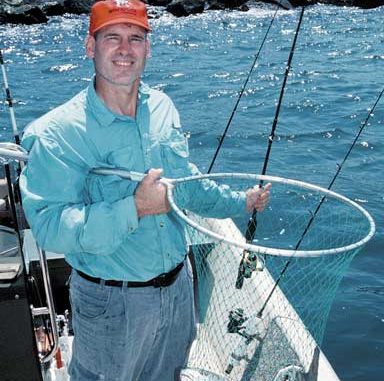
From the docks to Masonboro Inlet’s jetties, Wrightsville’s red drum offer excitement to anglers this summer.
When summer arrives, plenty of Tar Heel anglers head for saltwater areas, and one of their favorite fish to catch is red drum. In the not-too-distant past, red drum were scarce at the southeastern coastline. But now, thanks to good management plans, they have returned in numbers. Anglers can head out from Wrightsville Beach with a certainty of catching redfish — if they know a few minimal techniques and have an idea of where to find fish.
Two favorite techniques for Wrightsville Beach redfish are bottom-fishing in the rumbling surf against the Masonboro Inlet jetties and tumbling baits along the bottom beneath local boat docks with the aid of the tidal flow.
One of the best local guides who practices both of these bait presentations is Capt. Rick Bennett. Bennett has operated Rod-Man Charters for 12 years and builds custom fishing rods tailored to catching saltwater gamefish, including redfish.
“On a good day, we’ll catch anywhere from eight to 14 redfish, in sizes from the high teens to the mid-20s (inches),” he said. “They’re mostly slot-limit (18 to 27 inches in length) fish, and if someone wants to keep their limit of one, they certainly can.
“We’ve had a good redfish year so far, considering it was a rainy spring. We had several days in a row when we’ve caught between 17 and 22 redfish.”
Bennett heads out of Seapath Marina at Wrightsville Beach in a 24-foot Nautic Star Bay Boat, powered by a 250-horsepower Yamaha four-stroke outboard. His boat is equipped with fore and aft casting platforms, a trolling motor and a Power Pole.
“The Power Pole has taken the fishing world by storm,” Bennett said. “I can’t imagine fishing without it. It’s really increased my efficiency dramatically.”
Bennett usually heads first for the ICW. He catches some live bait or uses cut shrimp if live bait is scarce. He uses mullet or menhaden but prefers menhaden because they’re easier to catch.
“If a big school of mullet is begging for a cast net to be dropped on it, I’ll catch some mullet,” he said. “But it’s usually easier to fill the live well with menhaden, and the redfish will bite either bait.”
Bennett scouts for potential redfish docks during days when he doesn’t have clients aboard. He looks for docks with certain characteristics before making a cast.
“What I’m looking for is a dock that has a relatively close proximity to a creek mouth,” he said. “The fish come out of the creeks during falling tide. If there’s a bar with oysters near the dock, it’s like icing on the cake.
“Scouting docks during low tide is best because low water reveals structure. It might be anything different that holds redfish — old dock pilings, oyster shells, or even a deep drop-off or channel.”
Bennett approaches a dock from the up-current side. He may catch fish from beneath the walkway of the dock or the floating dock or T-section at the ICW end.
“I put the Power Pole down to hold the boat above the dock,” he said. “Then it’s easy to cast the baits beneath the dock.
“Redfish are going to be right under it in the shade, and when one hits the bait, you have to pull him out of there fast.
“I fish with 20-pound Spiderwire UltraCast braid on a 6-½ to 7-foot medium action Rod-Man Custom rod and an Okuma VS 40 spinning reel. I tie the line to a No. 5 swivel and thread a 1 ½- to 2-ounce sinker above the swivel. I tie a 14- to 15-inch leader of 50- to 80-pound mono and use a No. 2 Eagle Claw wide bend hook.”
The trick to catching a redfish from beneath a dock is to pull him out using brute force. A redfish strike can occur the instant the bait hits the water or after it has been soaking a few minutes.
“I fish with all the drag the line can withstand without breaking,” Bennett said “When the fish strikes, I tell the angler to pull the fish out while walking away from the dock, and he can walk 24 feet in my boat. Once the fish is well away from the dock, then an angler can start pumping and reeling as he normally would.
“You have to get the fish coming toward you fast, or he’ll tangle the line around the pilings.”
In addition to live baits, Bennett also uses scent-impregnated trailers fished with jig heads. He uses a ¼-ounce Bass Assassin jig head with a Berkley Gulp 3-inch shrimp in New Penny or Molting color.
“A jig is great for fishing docks,” he said. “Make one good cast, and you can let the current pull it under the dock. Then, by lifting the rod and letting it back down again, you can put it right in the fish’s face over and over until he eats it.”
A good red drum dock will hold several dozen fish. But Bennett doesn’t want to wear out his welcome. He uses a light-touch approach to fishing big fish concentrations.
“If I’m fishing alone, and I catch one redfish, I stop fishing and go somewhere else,” he said. “I save those fish for my clients. I never let my clients catch more than five or six fish from one dock. With a charter of three clients, that’s a couple of fish apiece before we head for another spot and do it again. You fish a school too hard and they’ll leave or stop biting.”
Bennett also fishes at the Masonboro Inlet jetties. He said the best fishing occurs at the inlet between the full and new moons.
“The week of the full moon and the week of the new moon we have some strong tides,” he said. “Redfish stay back in the marshes because the tide is higher. But the other two weeks of the month, I like to fish the jetties on the incoming tide. I anchor and cast baits to the tips of the jetties.”
Besides timing moon phases anglers should keep an eye on another environmental factor, the barometric pressure. A moving barometer can doom a fishing trip.
“A high barometer is better than a low barometer,” he said. “But whenever the barometer is moving up or down fast, the fish go to the bottom and don’t move very much. I also don’t like fishing during a northeast wind. Fishing is best if the wind is out of the southwest.
Stuart Caulder has fished the same area his entire live and is now in his eighth year of operating Gold Leader Guide Service. He fishes a Triton 24 LTS center console with a 225-hp Suzuki four-stroke outboard engine. Like Bennett, he also uses trolling motor and a Power Pole. Unlike Bennett, he likes it when nor’easters arrive.
“When that first big nor’easter arrives in July, the red drum fishing really picks up,” he said. “But in June, I work the creek mouths along the ICW with topwater lures.”
Caulder prospects for redfish at the mouths of Whiskey, Bradley, Pages and Hewletts creeks. He uses a walk-the-dog lure while watching for signs of redfish.
“I use the trolling motor to pull off the waterway,” he said. “I position the boat to where the very end of casts reach bank.
“The reason I like the topwater lure is because it casts so far and covers a lot of water fast. I have one guy working bank and one working water close to the boat, with the best time from the mid-high tide through mid-low tide when there’s enough water to get back in the creeks. The tide range really impacts where you can fish.
“Once an angler entices a fish to strike a topwater lure or if we spot fish feeding, waking or finning, we usually switch to a jig or spinnerbait.
“I like the Cajun Thunder spinnerbait or DOA paddle-tail grubs with a 1/8-ounce jig head in red-and-white colors. I use the light jighead because I don’t want a loud plop when it hits. You cast beyond the fish and bring it back by them so they don’t get spooky.
‘If we happen to stumble up on them, we’ll catch one right away. But if that happens I act with caution. I don’t want to scare them, so I watch their movement patterns for a few minutes then ease my boat into the middle of their circulation area and put the Power Pole down. I keep catching one or two fish every time the school moves by. I don’t chase them. If you do, you just move them faster and faster and chase them out of the area.”
Caulder said redfish usually remain in same areas day after day as long as they aren’t beaten up too badly. He catches no more than six fish from a school of 25 or 30 redfish before moving to another spot.
“You can still make some 15- to 25-fish days if you can locate several schools,” he said. “But you don’t want to fish a school so hard that it leaves because you’ll have to search for a new school.”
Fly anglers also can have some red drum fun in the creeks. Caulder has his fly anglers get out of the boat and wade.
“I can get closer to the fish by wading,” he said. “I pull my boat to the side of the area holding the fish then wade until we spot them. We wade ahead of them and wait for them to come to us. If you try to chase them, they’ll eventually start swimming away from every little movement, and it can get tough to fly cast to them after that.”
Caulder also heads to the Masonboro Inlet rock jetties when the conditions are right. He said three or four days before to three or four days following a full moon are bad days to catch reds at the jetties, except at night.
“At the rock jetties I fish with live baits,” he said. “I anchor up on the tips of the jetties and fish inside of jetties on the falling tide and outside of the jetties on the rising tide. It’s a good trip for kids because there’s not a lot of casting and reeling.
“You just cast out a Carolina rig with a live menhaden or mullet, put the rods in the rod holders and wait for a bite. It’s best to stagger the lines in a pattern so (fish) don’t get tangled. When one doubles over, you have a fish on.
“Most of the fish will be slot-limit fish, but some will be smaller or larger. Typically on the rock jetties, fish tend to be between 4 pounds to 15 or 16 pounds. Sometimes a big 20- or 30-pounder will come through, especially later in the fall. When that happens, if you can’t get the anchor up fast enough, he’ll cut you off on the rocks.”
Caulder uses a fairly heavy rod that serves multiple duty for several species. Like Bennett, he uses spinning rigs because they’re the easiest type of rig for inexperienced clients to handle.
“I fish with a Quantum 7-foot, 12- to 20-pound class rod with a Quantum Cabo size 30 reel spooled with 20-pound Suffix braid,” he said. “The braid has a little less drag and is more resistant to cutoffs. It also allows longer casts than monofilament.
“For fishing the jetties, I use a Carolina rig with a 1-ounce weight, 18 inches of 30-pound fluorocarbon leader and a Light Mutu Circle Hook in 3/0 or 4/0 size. The hook is big enough that the fish can’t get it back in his throat but small enough to get inside his mouth.”
Bennett lands his redfish with a coated Nylon net to control them and keep them from injuring themselves while he removes the hooks.
Caulder uses a Boga Grip device to handle the fish if the angler wants to take photos. Otherwise, he tries to de-hook a fish while it’s in the water.

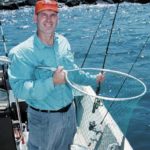
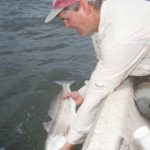
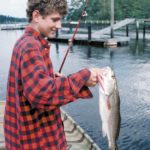
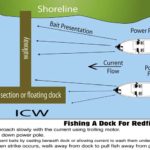
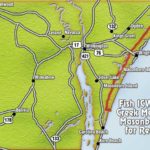
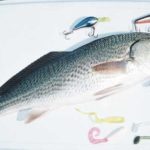
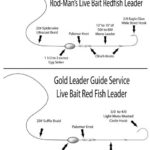
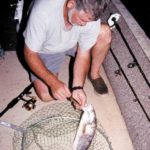



Be the first to comment